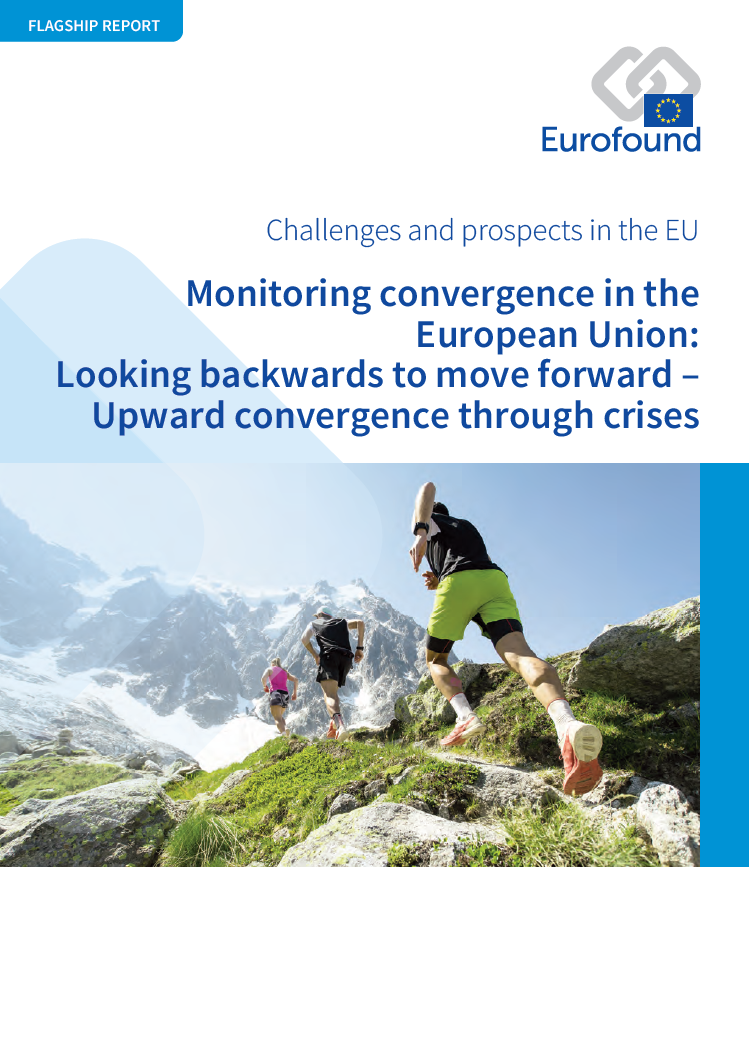
A convergência ascendente está no cerne do projeto da UE. Os Estados-Membros e os seus cidadãos à União, pois esperam que a sua adesão conduza a uma prosperidade económica equilibrada e ao progresso social entre países. O aumento das disparidades entre os Estados-Membros, como aconteceu durante a crise económica de 2008-2013, pode ser visto como uma traição à promessa da UE, e potencialmente lançar as sementes do descontentamento e da desintegração. Este relatório emblemático é o culminar da investigação da Eurofound no acompanhamento da convergência na UE, que foi iniciada em 2017. Descreve as dinâmicas variáveis da convergência ascendente durante o período de 2008-2019, explora o impacto a curto prazo da COVID-19 nas economias e sociedades europeias, bem como as suas implicações para a convergência, e discute os efeitos a longo prazo da pandemia e o futuro da convergência ascendente económica e social na Europa.
Key findings
A crise económica (2008-2013) teve um impacto negativo significativo na convergência ascendente entre os Estados-Membros. No entanto, enquanto a convergência económica foi rapidamente restaurada, a divergência descendente nas áreas do emprego e condições de vida prevaleceram até 2013, salientando até que ponto a convergência social e a económica estão correlacionadas.
Enquanto vários indicadores sociais começaram a convergir no sentido ascendente durante o período de recuperação de 2014-2019, a crise económica deixou um legado geográfico desigual. Enquanto a Europa central e oriental continuaram a convergir fortemente no sentido da região dominante norte-ocidental, a Europa do sul foi progressivamente sendo deixada para trás tanto a nível social como económico.
Entre 2008 e 2019, a convergência ascendente na qualidade da governação e instituições entre os Estados-Membros da UE foi basicamente inexistente. No contexto da crise de COVID-19, a convergência na qualidade institucional será uma importante forma de traduzir a convergência económica em convergência social duradoura no leste europeu e melhorar ambas no sul da Europa.
As respostas políticas fortes ao nível nacional e da UE à pandemia evitaram um impacto mais devastador e desequilibrado da crise nos mercados de trabalho e nas condições de vida da UE. No entanto, como a crise de COVID-19 não está totalmente terminada, será fundamental manter estes esforços políticos, especialmente no contexto da transição ecológica e digital em que os instrumentos políticos certos serão essenciais para impedir novas divergências entre o nordeste e o sudoeste.
A implementação completa dos planos NextGenerationEU será fundamental e a convergência entre os Estados-Membros da UE dependerá do grau de sucesso do alinhamento dos planos de recuperação nacional com a visão a nível da UE. A vontade dos governos de se concentrarem em prioridades supranacionais é uma oportunidade para inverter as desigualdades criadas pela pandemia da COVID-19, e a coordenação ao nível da UE será especialmente importante.
The flagship report contains the following list of tables and figures.
List of tables
Table 1: Overview of indicators
Table 2: Drivers of employment in the EU (panel analysis)
Table 3: Drivers of employment growth in the EU (panel analysis)
Table 4: Summary of economic convergence trends in sigma, delta and beta convergence and at the regional level
Table 5: Summary of social convergence trends in sigma, delta and beta convergence and at the regional level
Table 6: Summary of institutional convergence trends in sigma, delta and beta convergence
Table A1: Drivers of employment in the EU (panel analysis)
Table A2: Drivers of employment growth in the EU (panel analysis)
Table A3: Impact of unemployment changes on GDP per capita (regression coefficients), EU27, 2000–2019
List of figures
Figure 1: The three dimensions of convergence
Figure 2: Sigma and delta convergence in GDP per capita (PPS), EU27, 2008–2019
Figure 3: Unconditional beta convergence in GDP per capita (PPS), EU27, 2008–2019
Figure 4: Regional quintile clusters of GDP per capita in PPS in 2008 and 2019 and cluster mobility from 2008 to 2019, EU NUTS 2
Figure 5: Sigma and delta convergence in disposable household income per capita (PPS), 2008–2019
Figure 6: Unconditional beta convergence in disposable household income per capita (PPS), 2008–2019
Figure 7: Regional quintile clusters of disposable household income per capita in PPS in 2008 and 2019 and cluster mobility from 2008 to 2019, EU NUTS 2
Figure 8: Sigma and delta convergence in income inequality (income quintile share ratio), EU27, 2008–2019
Figure 9: Unconditional beta convergence in income inequality (income quintile share ratio), EU27, 2008–2019
Figure 10: Sigma and delta convergence in monthly minimum wage (PPS), 2008–2019
Figure 11: Unconditional beta convergence in monthly minimum wage (PPS), 2008–2019
Figure 12: Sigma and delta convergence in the employment rate (%), EU27, 2008–2019
Figure 13: Unconditional beta convergence in the employment rate (%), EU27, 2008–2013 and 2013–2019
Figure 14: Regional quintile clusters of the employment rate in 2008 and 2019 and cluster mobility from 2008 to 2019, EU NUTS 2
Figure 15: Sigma and delta convergence in the unemployment rate (%), EU27, 2008–2019
Figure 16: Unconditional beta convergence in the unemployment rate (%), EU27, 2008–2013 and 2013–2019
Figure 17: Regional quintile clusters of the unemployment rate in 2008 and 2019 and cluster mobility from 2008 to 2019, EU NUTS 2
Figure 18: Sigma and delta convergence in the gender employment gap (%), EU27, 2008–2019
Figure 19: Unconditional beta convergence in the gender employment gap (%), EU27, 2008–2019
Figure 20: Regional quintile clusters of the gender employment gap in 2008 and 2019 and cluster mobility from 2008 to 2019, EU NUTS 2
Figure 21: Sigma and delta convergence in the youth NEET rate (%), EU27, 2008–2019
Figure 22: Unconditional beta convergence in the youth NEET rate (%), EU27, 2008–2013 and 2013–2019
Figure 23: Regional quintile clusters of the youth NEET rate in 2008 and 2019 and cluster mobility from 2008 to 2019, EU NUTS 2
Figure 24: Sigma and delta convergence in the early school leavers rate (%), EU27, 2008–2019
Figure 25: Unconditional beta convergence in the early school leavers rate (%), EU27, 2008–2019
Figure 26: Regional quintile clusters of the early school leavers rate in 2008 and 2019 and cluster mobility from 2008 to 2019, EU NUTS 2
Figure 27: Sigma and delta convergence in the AROPE rate (%), EU27, 2008–2019
Figure 28: Unconditional beta convergence in the AROPE rate (%), EU27, 2008–2013 and 2013–2019
Figure 29: Sigma and delta convergence in unmet medical needs (%), EU27, 2008–2019
Figure 30: Unconditional beta convergence in unmet medical needs (%), EU27, 2008–2019
Figure 31: Sigma and delta convergence in the WGI rule of law, EU27, 2008–2019
Figure 32: Unconditional beta convergence in the WGI rule of law, EU27, 2008–2019
Figure 33: Sigma and delta convergence in the WGI government effectiveness, EU27, 2008–2019
Figure 34: Unconditional beta convergence in the WGI government effectiveness, EU27, 2008–2019
Figure 35: Sigma and delta convergence in the WGI regulatory quality, EU27, 2008–2019
Figure 36: Unconditional beta convergence in the WGI regulatory quality, EU27, 2008–2019
Figure 37: Sigma and delta convergence in the WGI voice and accountability, EU27, 2008–2019
Figure 38: Unconditional beta convergence in the WGI voice and accountability, EU27, 2008–2019
Figure 39: Sigma and delta convergence in the WGI control of corruption, EU27, 2008–2019
Figure 40: Unconditional beta convergence in the WGI control of corruption, EU27, 2008–2019
Figure 41: Sigma and delta convergence in the Ease of Doing Business score, EU27, 2010–2019
Figure 42: Unconditional beta convergence in the Ease of Doing Business score, EU27, 2010–2019
Figure 43: Regional clusters of the European Quality of Government Index score (EQI), EU NUTS 1 and 2, 2010 and 2017
Figure 44: Employment rates in the previous year and annual growth rates by EU Member State, 2000–2019
Figure 45: Employment growth in southern and central and eastern countries relative to western/northern Europe (regression coefficients plot)
Figure 46: Summary of the regional leaders and laggards in the social dimension and cluster mobility in the economic dimension, EU NUTS 2, 2008–2019
Figure 47: Relationship between GDP and unemployment in 2008–2009 (growth rates), EU27
Figure 48: Relationship between GDP and unemployment in 2019–2020 (growth rates), EU27
Figure 49: Actual versus predicted unemployment rate in 2020 (%), EU27
Figure 50: SURE loans and the unemployment gap in 2020, EU27
Figure 51: Unweighted average employment rate and projections to meet the European Pillar of Social Rights Action Plan 2030 target (%), EU27
Figure 52: Unweighted average youth NEET rate and projections to meet the European Pillar of Social Rights Action Plan 2030 target (%), EU27
Figure 53: Sigma convergence in GDP per capita (PPS), EU27, 2013–2020
Figure 54: Change in GDP per capita (in PPS) by Member State (%), EU27, 2019–2020
Figure 55: Unconditional beta convergence in GDP per capita (PPS), EU27, 2019–2020
Figure 56: Percentage change in GDP per capita (in PPS), EU27, 2019–2020
Figure 57: Sigma convergence in the unemployment rate (%), EU27, 2013–2021 (monthly data: January 2020–May 2021)
Figure 58: Change in unemployment rate by Member State (percentage points), EU27, 2019–2020
Figure 59: Unconditional beta convergence of the unemployment rate (%), EU27, 2019–2020
Figure 60: Percentage point change in the unemployment rate, EU NUTS 2, 2019–2020
Figure 61: Sigma convergence in the activity rate (%), EU27, 2013–2020 (quarterly data: Q4 2019–Q4 2020)
Figure 62: Sigma convergence in labour market slack (%), EU27, 2013–2020 (quarterly data: Q4 2019–Q4 2020)
Figure 63: Unconditional beta convergence in labour market slack (%), EU27, 2019–2020
Figure 64: Estimated change in the at-risk-of-poverty rate, EU, 2019–2020
Figure 65: Sigma convergence in the youth NEET rate (%), EU27, 2013–2020 (quarterly data: Q4 2019–Q4 2020)
Figure 66: Unconditional beta convergence in the youth NEET rate (%), EU27, 2019–2020
Figure 67: Degree of plausibility (on a scale of 1–10) of the health recovery scenarios as assessed by Eurofound experts
Figure 68: Possible economic recovery scenarios
Figure 69: Expected speed of economic recovery, EU27
Figure 70: Experts’ opinions on the expected economic crisis triggered by the COVID-19 pandemic (on a scale of 0–100)
- Number of pages
-
120
- Reference nº
-
EF21008
- ISBN
-
978-92-897-2237-7
- Catalogue nº
-
TJ-01-21-504-EN-N
- DOI
-
10.2806/78744
- Permalink
Cite this publication
Eurofound (2021), Monitoring convergence in the European Union: Looking backwards to move forward – Upward convergence through crises, Challenges and prospects in the EU series, Publications Office of the European Union, Luxembourg.
